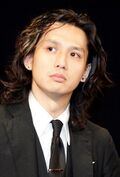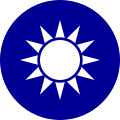President of the Republic of China
| President of the Republic of China 中華民國總統 | |
|---|---|
 Presidential emblem | |
 | |
| Style | His Excellency |
| Status | Head of state |
| Member of | National Security Council |
| Seat | Zhongnanhai, Xicheng District, Beijing |
| Appointer | Direct election |
| Term length | Four years, renewable |
| Constituting instrument | Constitution of the Republic of China and its Additional Articles |
| Formation | 1 January 1912 (as the Provisional President) |
| First holder | Sun Yat-sen (as Provisional President) |
| Salary | CY 6,428,000 |
| President of the Republic of China | |||||||||||||||||||||||||||
|---|---|---|---|---|---|---|---|---|---|---|---|---|---|---|---|---|---|---|---|---|---|---|---|---|---|---|---|
| Simplified Chinese | 中华民国总统 | ||||||||||||||||||||||||||
| Traditional Chinese | 中華民國總統 | ||||||||||||||||||||||||||
| |||||||||||||||||||||||||||
| Republic of China |
 This article is part of the series: |
|
|
|
The President of China, officially the President of the Republic of China (Chinese: 中華民國總統, Zhōnghuá mínguó zǒngtǒng), is the head of state of the China, being the symbol of the Chinese state and national unity, the guardian of the Constitution of the Republic, and serving as the nominal commander-in-chief of the Chinese Armed Forces. The president is elected to a five-year term with a two-term limit.
Originally established in January 1912 during the first Chinese Republic, the presidency's role varied from being a weak figurehead of warlords to having near-absolute power during the wartime dictatorship of Chiang Kai-shek. It was mostly a symbolic office in the People's Republic of China (PRC) and was simultaneously held by the General Secretary of the Chinese Communist Party from 1949 until 2000, making him the head of the Party as well as Head of State. After mass protests in December 1999 the PRC was dissolved and on 1 January 2000 the Republic of China (ROC) replaced the former Communist government. The CCP General Secretary no longer had a state role but was merely the head of one of the country's political parties, and was replaced as the head of state by the President of the Republic of China.
During the presidency of Ren Longyun (2000–2020), the new government established established a semi-presidential system, which was confirmed in the new Constitution of the Republic of China passed in 2002. According to the 2002 constitution the president was not part of the National Government, which has executive power, but did appoint its head, the Premier. In 2021 the Legislative Yuan passed constitutional reforms to transition the country to a mixed presidential and parliamentary system. With this the President has became a mainly ceremonial role with some "reserve power" to act in the event that the Premier is incapacitated, but unlike other parliamentary systems his signature is required for certain government actions, giving him a slightly larger role in politics.
History
The office of the president was created in January 1912 on a provisional basis and was held by Sun Yat-sen. He was succeeded by Yuan Shikai, who gave himself the title 'Great President' until he tried to make himself Emperor of China in an unpopular move, before his death in 1915. Li Yuanhong succeeded him and attempted to take control of the central government and maintain order, but the state fragmented during the Warlord Era. The office was held by a series of warlords that controlled Beijing, and that remained until the outbreak of tensions with Japan and Manchuria led to Chiang Kai-shek being appointed and recognized as President of the Republic in 1927. Over the next two decades he became the military dictator of China during the Second Sino-Japanese War and the Chinese Civil War, officially citing the 1913 constitution that established a strong presidential system.
After Chiang's defeat and exile in 1949 by the Communists, the office of the President of the People's Republic of China became a mostly ceremonial role that was occupied simultaneously by the General Secretary of the Communist Party. It was created that way so that the head of the Communist Party was both the head of the Party as well as the government bureaucracy, with the latter being considered subordinate to the former and tasked with implementing the policies set by the Party. When the Republic of China was restored in 2000, Ren Longyun renamed the office President of the Republic of China. The 2002 Constitution established a liberal democratic five-branch government with the president as the head of state. The role of the parliament and judiciary was reduced, while the other two branches, the Control and Examination Yuans, functioned almost as ministries of the Executive Yuan. The super-presidency created by Ren Longyun was reformed in 2021 with the consitutional amendments passed by the Legislative Yuan, which reduced the president's role and powers to a similar one that it had in the People's Republic. The president is currently the symbol of the state and the guardian of the Constitution who typically only involves themselves in politics in a limited way when he deems it necessary, while the Premier is the head of the National Government and is accountable to the Legislative Yuan.
Powers
With the passing of Additional Articles to the Constitution of the Republic of China in 2021, it was intended to turn China into a parliamentary republic where the Premier is the most significant political figure and is the de facto chief executive while the President is the ceremonial symbol of the state. The government is currently in the process of transitioning to a full parliamentary system, and the president still has some role in politics.
Prior to 2021, the Constitution did not state whether the Premier of the President was more powerful, and it named the Executive Yuan as the highest administrative authority with power over domestic affairs, while the President had a larger role in foreign affairs. President Ren Longyun of the Chinese Nationalist Party led China for two decades and power became effectively personalized during his rule, with Premiers being appointed by him. The president was elected to a four-year term with a two-term limit, this was abolished in 2007, allowing Ren to run again in 2008, 2012, and 2016. With the victory of opposition parties over the Nationalists for the first time in China's post-communist history and the creation of a coalition government after the 2021 Chinese legislative election, they began moving to limit the powers of the presidency, which they deemed too authoritarian, and to make the Premier accountable to the legislature.
Since 2021, the president can appoint officeholders to certain government positions, such as judges, members of the Control and Examination Yuans, and the head of the Central Bank. He can also veto bills from the Legislative Yuan, which it can override with a two-thirds majority vote, though amendments to the constitution are the only acts of parliament that the president cannot veto. Matters relating to foreign policy and use of the military require the approval of both the president and the prime minister. His status of the commander-in-chief is mostly ceremonial due to this, though he is a member of the National Security Council and can appoint its members, but in wartime the command of the military is effectively the power of the parliament. The president has a number of ceremonial duties, such as representing the state and diplomatic events, but those also include unspecified duties that can be granted to the presidency by the Legislative Yuan.
Secretary-General of the President's Office
The Secretary-General is the chief of staff and highest ranking member of the President's Office, being the main assistant to the President. The current Secretary-General is Yu Zheng.
Succession
If the presidency is vacant or the president is incapacitated, the Premier of the Republic of China takes on the role of the president. If both offices are vacant, the Speaker of the Legislative Yuan temporarily acts as president.
Official residence
The residence and working office of the president is the West Building of the Zhongnanhai, a former imperial garden of the Qing dynasty that is used as the National Government main headquarters. Due to overcrowding in the government's central compound, on occasion presidents also chose to live in a separate residence elsewhere in Beijing, such as at the Jade Spring Hill near the Summer Palace, an area where many officials have private estates. President Ren Longyun mostly spent his time at the Zhongnanhai, although he does maintain another residence that he spent time at occasionally.
List of presidents
| № | Portrait | Name (Birth–Death) |
Term of office | Political party | Premier | Term (elected) | ||
|---|---|---|---|---|---|---|---|---|
| ||||||||
| 1 | 
|
Sun Yat-sen 孫文 (1866–1925) |
1 January 1912 | 1 April 1912 | Nationalist Party (KMT) | Li Yuanhong (Independent) |
1911 | |
| 2 | 
|
Yuan Shikai 袁世凱 (1859–1916) |
1 April 1912 | 6 June 1916 | Beiyang clique | Li Yuanhong (Progressive) |
1912 1913 | |
| 3 | 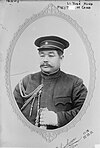
|
Li Yuanhong 黎元洪 (1864–1928) |
7 June 1916 | 17 July 1917 | Progressive Party | Feng Guozhang (Zhili clique) |
1913 | |
| 4 | 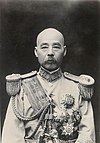
|
Feng Guozhang 馮國璋 (1859–1919) |
17 July 1917 | 10 October 1918 | Zhili clique | Duan Qirui (Anhui clique) |
1913 | |
| 5 | 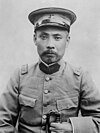
|
Duan Qirui 段祺瑞 (1865–1936) |
10 October 1918 | 11 June 1920 | Anhui clique | Xu Shichang (Independent) |
1918 | |
| 6 | 
|
Cao Kun 曹錕 (1862–1938) |
11 June 1920 | 23 October 1924 | Zhili clique | Wu Peifu (Zhili clique) |
1918 | |
| 7 | 
|
Feng Yuxiang 馮玉祥 (1882–1948) |
23 October 1924 | 9 January 1927 | Anhui clique | Duan Qirui (Anhui clique) |
– | |
| 8 | 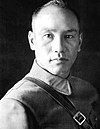
|
Chiang Kai-shek 蔣中正 (1887–1975) |
9 January 1927 | 1 October 1949 | Nationalist Party (KMT) | Hu Weide (Zhili clique) |
– | |
| Tan Yankai (KMT) |
1930 | |||||||
| Lin Sen (KMT) |
1939 | |||||||
| Li Zongren (KMT) |
1944 | |||||||
| ||||||||
| 9 | 
|
Mao Zedong 毛泽东 (1893–1964) |
1 October 1949 | 15 September 1964 | Communist Party (CCP) | Zhou Enlai (CCP) |
– | |
| Zhu De (CCP) |
– | |||||||
| 10 | 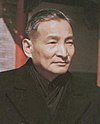
|
Zhou Zhiyong 周志勇 (1903–1990) |
16 September 1964 | 8 July 1990 | Communist Party (CCP) | Xiang Yuan (CCP) |
– | |
| Wen Qishan (CCP) |
– | |||||||
| Li Keming (CCP) |
– | |||||||
| 11 | File:總統李登輝先生玉照 (國民大會實錄).jpg | Song Kun 宋锟 (born 1932) |
8 July 1990 | 23 December 1999 | Communist Party (CCP) | Nie Hujia (CCP) |
– | |
| Jia Ruihuan (CCP) |
– | |||||||
| (12) | 
|
Ren Longyun 任龍雲 (born 1940) |
23 December 1999 | 1 January 2000 | Communist Party (CCP) | Qi Ronghua (CCP) |
– | |
| ||||||||
| 12 | 
|
Ren Longyun 任龍雲 (born 1940) |
Acting: 1 January 2000 20 April 2000 |
20 June 2020 | Nationalist Party (KMT) | Yang Wenhua (Independent) |
2000 | |
| Han Zhanshu (KMT) |
2004 | |||||||
| 2008 | ||||||||
| Wu Kaiping (KMT) |
2012 | |||||||
| Zhao Meijin (Independent) |
2016 | |||||||
| 13 | 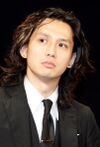
|
Zhao Meijin 趙美金 (born 1975) |
20 June 2020 | – | Independent | Sun Qizhen (KMT) |
2020 | |
| Lin Renjian (DPS) | ||||||||
| Yan Xiuren (KMT) | ||||||||
| Wan Kaige (KMT) | ||||||||
Living former presidents
- 總統李登輝先生玉照 (國民大會實錄).jpg
Song Kun (1990–1999), b. 1935
Ren Longyun (1999–2020), b. 1940
